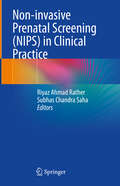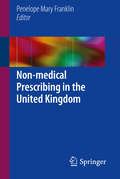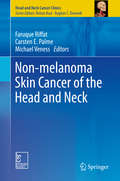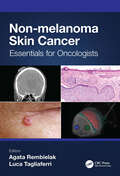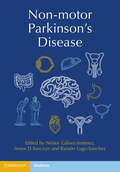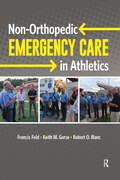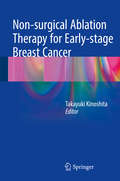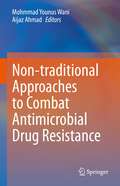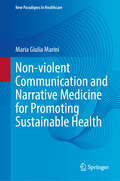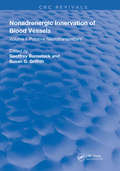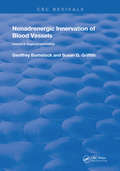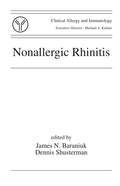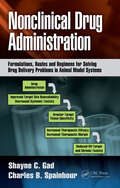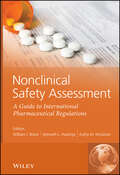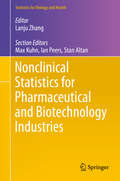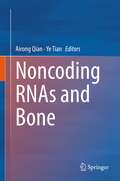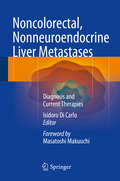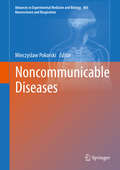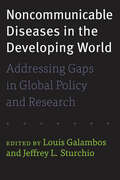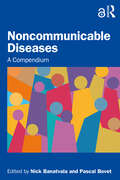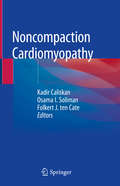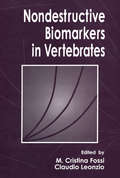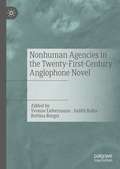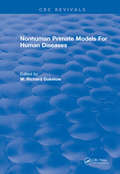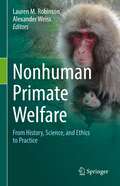- Table View
- List View
Non-invasive Prenatal Screening (NIPS) in Clinical Practice
by Riyaz Ahmad Rather Subhas Chandra SahaThe book provides a comprehensive overview of the use of non-invasive prenatal screening (NIPS) in clinical practice. It covers advanced genomic approaches and operational strategies related to NIPS. It aims to fill a gap by offering a thorough historical background and genesis of NIPS technology, including its methodology, clinical utility, challenges, and future directions. The book is divided into three sections: Section I discusses the advent of NIPS, Section II addresses detection strategies and clinical implementation, and Section III explores the challenges and prospects of NIPS technology. The book benefits specialists who practice prenatal medicine as well as reproductive specialists, genetic councilors, research scholars and postgraduate medical students of obstetrics and gynecology.
Non-medical Prescribing in the United Kingdom
by Penelope Mary FranklinThis book explores key developments in Non-medical Prescribing in the UK. Addressing the needs of countries in the European Market and beyond, which have been closely watching UK developments and would be interested in embedding or developing counterparts of their own. Featuring chapters by clinicians, leaders and practitioners in the UK Non-medical Prescribing arena, it identifies both current and potential future developments. Attention is paid to the different prescribing practices and governance within the four countries constituting the United Kingdom. Many lessons have been learned along the way and the purpose of this book is to share these lessons, tog ether with best practice examples in connection with the implementation of nurse/health professional led patient care, implementation of patient centered practice, and governance. Designated Registered Practitioners who have completed an enhanced training now receive a professional body qualification which enables them to prescribe within their scope of practice as Non-medical Independent Prescribers and, providing that they are competent, from anywhere within the British National Formulary independently of doctors; for Nurses, this also includes most controlled drugs. The book will be of interest to policy makers and to forward-looking professionals and practitioners in the diverse European Healt h and Social Care market.
Non-melanoma Skin Cancer of the Head and Neck
by Faruque Riffat Carsten E. Palme Michael VenessNon-melanoma skin cancer is a global public health issue. With an ever-increasing, and ageing, world population coupled with increasing numbers of immunosuppressed individuals the number of patients continues to rise. The head and neck is overwhelmingly the most frequent location for the development of a non-melanoma skin cancer and as such challenges the clinician with its complex anatomy. The importance of maintaining the aesthetics of the face and the function of the anatomy cannot be overstated, yet ultimately it is always the aim of curing a patient with the minimum of morbidity that clinicians strive for. However, the spectrum of presentations and subsequent management varies widely, ranging from patients with the ubiquitous low-risk mid-face basal cell carcinoma to those diagnosed with relatively uncommon but potentially life-threatening high-risk squamous cell carcinomas (e. g. involving metastatic lymph nodes or with perineural invasion present) and Merkel cell carcinomas.
Non-melanoma Skin Cancer: Essentials for Oncologists
by Agata Rembielak and Luca TagliaferriThis book provides a comprehensive introduction to the current state-of-the-art in skin cancer, exploring the recent developments, appraising the current evidence and providing future directions with particular emphasis on interdisciplinary collaboration and need for clinical trials. It covers all aspects of skin cancers, including epidemiology, pathology, surgical and non-surgical treatments. It will be a valuable reference for oncologists, dermatologists, dermatopathologists, surgeons, allied health care professionals and other specialists and trainees with a special interest in skin cancer who want to update their knowledge in the multidisciplinary management of such patients. The book will be of interest to medical physicists and radiographers who would like an overview of the current practice in skin cancer. The book can be used by students in medicine, nursing, radiography and medical physics. Features Provides a comprehensive review of all aspects of skin cancer management. Edited by experts in the area, with interdisciplinary and international collaborators. Promotes a 'Bigger picture' approach to the topic with multidisciplinary insight.
Non-motor Parkinson's Disease
by Néstor Gálvez-Jiménez Amos D. Korczyn Ramón Lugo-SanchezNon-motor Parkinson's Disease is a burgeoning area of the movement disorders field, as patients increasingly live longer and encounter more late-stage symptoms. The spectrum of non-motor manifestations spans much of the body, with non-motor features occurring in all stages of the disease. Identification of symptoms is key for preserving quality of life and successful treatment. This is a practical manual on all aspects of pre-motor and non-motor manifestations of Parkinson's. The genetic causes of non-motor symptoms are detailed and methods of patient evaluation summarized. Topics such as autonomic and sexual dysfunction, mood disorders, and drug-induced symptoms of non-motor Parkinson's are covered in depth. This is an essential resource for movement disorder specialists, neurologists and other clinicians involved in caring for those with Parkinson's disease.
Non-orthopedic Emergency Care in Athletics
by Francis Feld Keith Gorse Robert BlancNon-Orthopedic Emergency Care in Athletics is a textbook that will help instruct athletic training students, certified athletic trainers, and other health care providers about the emergency medical situations they can potentially face throughout their careers. Francis Feld, Keith M. Gorse, and Robert O. Blanc, along with their contributors, have covered the most crucial types of serious medical emergencies that may be encountered in sports. Also included is material for each of the Domains listed in the NATA Board of Certification (BOC) and the Education Competencies and Proficiencies listed in the 2020 CAATE Standards. What is covered inside Non-Orthopedic Emergency Care in Athletics: Design and Implementation of Emergency Action Plans & Standard Operating Procedures Mass Casualty Substance Abuse Cardiac and Respiratory Care Endocrine Emergencies Environmental Conditions Shock Seizures Abdominal Emergencies Psychiatric Issues Bleeding Disorders Non-Orthopedic Emergency Care in Athletics is an ideal text for certified athletic trainers, athletic training students, and other health care providers focusing on the skills, knowledge, practice, and preparation needed to handle real athletic emergency medical situations.
Non-surgical Ablation Therapy for Early-stage Breast Cancer
by Takayuki KinoshitaCovering the history of breast cancer, theory of radiofrequency ablation (RFA), resection of carcinoma, imaging before and after non-surgical ablation therapy and quality of life, this book focuses on extensive breast-conserving treatment for the preservation of a cosmetically acceptable breast. It investigates the feasibility of percutaneous, minimally invasive techniques to ablate breast tumors and several modalities such as cryosurgery, laser ablation, thermoablation and high-intensity focused ultrasound. Non-surgical Ablation Therapy for Early-stage Breast Cancer centers on RFA and provides insights into cryoablation and focused ultrasound surgery. RFA has been shown to be effective for treating tumors in many types of tissue, including liver, bone, brain, kidney, pancreas and prostate. As such this book is a valuable resource for breast and general surgeons, radiation oncologists and medical oncologists in all areas. The extensive discussions enable scholars to gain radiological expertise and a basic understanding of molecular biology, leading to better surgery without scalpels.
Non-traditional Approaches to Combat Antimicrobial Drug Resistance
by Mohmmad Younus Wani Aijaz AhmadThis book provides a detailed overview of the progress and challenges of non-traditional approaches for tackling antimicrobial resistance. The first chapter covers the factors that make microbes more likely to develop multidrug resistance. The book goes on to discuss the antimicrobial properties of propolis, essential oils and other microbial constituents that are used or under investigation to treat multidrug-resistant infections. Additionally, it covers alternative compounds that work as antimicrobial agents, their mechanisms of action, and how they might be utilized in conjunction with conventional drugs to circumvent drug resistance. The book explores the application of phage therapy and recent advancements in phage-based infection control with an emphasis on multidrug-resistant infections and discusses drug repurposing as a strategy to develop new antimicrobial agents efficiently and expeditiously. Additionally, it discusses the uses of nanoparticles in the treatment of infections brought on by multidrug-resistant pathogens and examines the use of different nanotechnology-based approaches to fudge microbial resistance mechanisms. It concludes by reviewing recent studies on microbial quorum-sensing systems and focuses on the significance of quorum-sensing systems in controlling microbial resistance mechanisms and at the same time highlights the importance and role of antimicrobial stewardship program to fight microbial infections. The book is an invaluable source of knowledge and information for academics, basic and clinical researchers, clinicians, and paramedic staff involved in one way or the other in the development and use of antimicrobial agents and strategies to combat multidrug resistance.
Non-violent Communication and Narrative Medicine for Promoting Sustainable Health (New Paradigms in Healthcare)
by Maria Giulia MariniThe Covid-19 pandemic and current international circumstances have left many individuals feeling vulnerable, both economically and psychologically. At the same time, pressure is put on healthcare systems, particularly in Europe, resulting in doctor shortages, heavy workloads, and low salaries for healthcare workers. Patients are experiencing longer waiting lists, shorter visiting times, and emergency rooms that underestimate patients' clinical problems. As a result, episodes of self-violence and violence resulting from different causes are happening more frequently, also in hospitals. However, there is hope, and it starts with sharing our needs, thoughts, and feelings. This is where narrative medicine comes into play, as it helps bring stories to light, listen, ask open questions, analyze the spoken words, metaphors, and timing of communication, and promote a non-violent narrative. The key is to transition from violent to non-violent narratives and the consideration of relationship as a fundamental part of the therapeutic process, deserving an in-depth educational program. This is even more true if one considers that the ecosystem of health, together with the inclusion of diversity and the promotion of peace, is one of the main pillars of the UN Sustainable Development Goals.This book aims to inspire care for one another through the narratives of people with disabilities, patients, nurses, doctors, students, carers, and individuals who meet otherness and resolve conflicts.
Nonadrenergic Innervation of Blood Vessels: Putative Neurotransmitters (Routledge Revivals #1)
by Geoffrey Burnstock Susan G. GriffithFirst Published in 1988, this book offers a full, comprehensive guide into the functions and treatment of the Blood Vessels. Carefully compiled and filled with a vast repertoire of notes, diagrams, and references this book serves as a useful reference for Students of Medicine, and other practitioners in their respective fields.
Nonadrenergic Innervation of Blood Vessels: Regional Innervation (Routledge Revivals #2)
by Geoffrey Burnstock Susan G. GriffithFirst Published in 1988, this book offers a full, comprehensive guide into the workings and treatment of the Blood Vessels. Carefully compiled and filled with a vast repertoire of notes, diagrams, and references this book serves as a useful reference for Students of Medicine, and other practitioners in their respective fields.
Nonallergic Rhinitis
by James N. Baraniuk Dennis ShustermanCompiled by an internationally recognized team of contributors, this reference spans methods to effectively identify, diagnose, and treat this frequently challenging group of rhinopathies. Addressing both generic and disease-specific issues, this source spans possible causes of nonallergic rhinitis such as fumes, odors, temperature, atmospheric cha
Nonclinical Drug Administration: Formulations, Routes and Regimens for Solving Drug Delivery Problems in Animal Model Systems
by Shayne C. Gad Charles B. SpainhourIf we will ever achieve Paul Ehrlich’s "magic bullet," that is, a molecule which goes with high selectivity to the therapeutic target site, does what it needs to do, and is subsequently cleared from the body, the practice of safety assessment will have to change. Nonclinical Drug Administration: Formulations, Routes and Regimens for Solving Drug Delivery Problems in Animal Model Systems seeks to address a trio of objectives that, though separate, are linked and central to biomedical science and, ultimately, medicine. Rather seeing these as separate "silos," those working in nonclinical safety assessment will have to view these three in an integrated manner and to regularly and thoughtfully incorporate new information and technology. The trio of objectives this book explores are: first, to present how to deliver more of a drug product systemically to facilitate the regulatory need for evaluating safety and efficacy in animal species (at elevated exposure levels) prior to advancing the drug to human testing; second is to achieve better tolerance to therapeutics administration in test animals and humans which achieves objectives 1 and 3; and third, to explore ways to improve on therapeutic target receptor delivery performance, therefore improving both clinical pharmacodynamics bioavailability and specificity. The book’s ten chapters assemble the basic concepts, principles and hypotheses involved in quantitative receptor and chronological organism interaction dynamics central to the successful development of new therapeutics which depend on systemic administration to achieve desired therapeutic goals and in so doing avoid outcomes which limit, marginalize, or preclude the therapeutic use of so many molecules.
Nonclinical Safety Assessment
by Kathy M. Mcgown William J. Brock Kenneth L. HastingsBringing a new drug to market is a costly time-consuming process. Increased regional and international regulation over the last twenty years, while necessary, has only served to amplify these costs. In response to this escalation, developmental strategies have shifted towards a more global approach. In order to create the most cost-effective and safe processes, it is critical for those bringing drugs to market to understand both the globally accepted regulations and the local variations. Nonclinical Safety Assessment: A Guide to International Pharmaceutical Regulations provides a practical description of nonclinical drug development regulations and requirements in the major market regions.It includes:ICH - the International Conference on Harmonisation of Technical Requirements for Registration of Pharmaceuticals for Human UseNational regulations, including US FDA, Canada, Mercosur and Brazil, South Africa, China, Japan, India and AustraliaRepeated dose toxicity studiesCarcinogenicity; Genotoxicity; Developmental and reproductive toxicology; ImmunotoxicologyBiotechnology-derived pharmaceuticalsVaccine developmentPhototoxicity and photocarcinogenicityDegradants, impurities, excipients and metabolitesPrimarily intended for those professionals actively involved in the nonclinical and clinical development of a pharmaceutical product, including toxicologists, pharmacologists, clinicians and project managers, this book provides a roadmap for successful new drug approval and marketing.
Nonclinical Statistics for Pharmaceutical and Biotechnology Industries
by Lanju ZhangThis book serves as a reference text for regulatory, industry and academic statisticians and also a handy manual for entry level Statisticians. Additionally it aims to stimulate academic interest in the field of Nonclinical Statistics and promote this as an important discipline in its own right. This text brings together for the first time in a single volume a comprehensive survey of methods important to the nonclinical science areas within the pharmaceutical and biotechnology industries. Specifically the Discovery and Translational sciences, the Safety/Toxiology sciences, and the Chemistry, Manufacturing and Controls sciences. Drug discovery and development is a long and costly process. Most decisions in the drug development process are made with incomplete information. The data is rife with uncertainties and hence risky by nature. This is therefore the purview of Statistics. As such, this book aims to introduce readers to important statistical thinking and its application in these nonclinical areas. The chapters provide as appropriate, a scientific background to the topic, relevant regulatory guidance, current statistical practice, and further research directions.
Noncoding RNAs and Bone
by Ye Tian Airong QianThe book provides an in-depth and comprehensive overview of the essential role of non-coding RNAs (ncRNAs) in bone formation. In combination with researches from multiple scholars in this field, the book reviews the mechanisms of ncRNA-related bone diseases, as well as the potential applications of RNA synthesis technology in bone disorder treatments. This volume covers the following topics: 1) basic introduction of non-coding RNA and bone development, how 2) microRNAs and 3) long noncoding RNAs (LncRNAs) regulate bone formation, 4) how ncRNAs and the corresponding pathways participate in bone metabolism diseases, 5) RNA synthesis technology and the possible RNA therapies in bone disease. Researchers and students in the fields of human genetics, human physiology, developmental biology and biomedical engineering, as well as professionals and scientists in Orthopedics, will particularly find this book helpful.
Noncolorectal, Nonneuroendocrine Liver Metastases
by Isidoro Di CarloThis book offers a complete overview on non colorectal non neuroendocrine (NCRNNE) liver metastases and describes in detail the currently available therapies. Each chapter focuses on the treatment of metastases from a particular primary malignancy and also provides valuable information on incidence, natural history and diagnosis. NCRNNE liver metastases are rare entities compared with colorectal and neuroendocrine metastases, for which the treatments are well codified. While more publications have appeared on the topic in recent years, an in-depth study has to date been lacking. Furthermore, most published series are insufficiently comparable as they comprise patients with NCRNNE hepatic metastases from a variety of primary malignancies and consequently overlook differences in tumor behavior, frequency of isolated hepatic metastases, response to neoadjuvant or adjuvant therapy and interval between diagnosis of the primary tumor and the liver metastases. This book, with its more specific approach, will serve not only as an up-to-date guide to diagnosis and treatment but also as a reference on which to base future studies.
Noncommunicable Diseases
by Mieczyslaw PokorskiDiseases of the respiratory system often cause multisystem dysfunction and morbidity. Respiratory diseases not transmissible by a direct contact are rarer than those of inflammatory or infectious background. Such noncommunicable diseases, often entailing genetic and immune aspects, are areas of limited understanding; sarcoidosis being a case in point. This book tackles the issues relevant to such diseases. The research on novel cytokine markers, which may help in the diagnosis and management of sarcoidosis, is described. Modern approaches to the management of pneumothorax, a frequent accompaniment of lung diseases or chest wall trauma are dealt with as well. There are also chapters that underscore the immuno-inflammatory mechanisms of disorders seemingly unrelated to respiration, such as obesity or aplastic anemia, which may appreciably affect the control of the respiratory system and thus its vulnerability to diseases. The book will be of interest to clinicians and medical researchers.
Noncommunicable Diseases in the Developing World: Addressing Gaps in Global Policy and Research
by Louis GalambosPresents a pragmatic agenda for achieving effective and sustainable global action on noncommunicable diseases in lower- and middle-income countries.Noncommunicable diseases (NCDs)—including cardiovascular disease, diabetes, asthma and other chronic respiratory conditions, and cancers—are the leading causes of death worldwide. An estimated 36 million people die from such diseases each year; this represents roughly two out of three deaths globally. Eighty percent of these fatalities occur in developing countries. The statistics are staggering, yet millions of these deaths are preventable. This is an urgent global health issue that demands analysis of gaps in NCD research, new policies and practices, and actionable recommendations to close the gaps.The Johns Hopkins Institute for Applied Economics, Global Health, and the Study of Business Enterprise convened an NCD Working Group of leading scholars to examine a wide range of issues that both the private and public sectors must address to make sustainable progress in NCD prevention and treatment in lower- and middle-income countries. Collected in this volume are essays on five key areas where strengthened policies and health systems can have the most impact in the near future.• Accelerating regulatory harmonization• Structuring supply chains• Improving access to interventions• Restructuring primary care• Promoting multisectoral and intersectoral actionWhile there is a growing literature on the problem of NCDs, none of the available studies provides background on the range of challenges matched with specific steps that can be taken by the public sector, private sector, and civil society working together. Noncommunicable Diseases in the Developing World presents a framework for understanding the salience of specific policy recommendations and detailed steps that can be taken now to move forward in the global campaign against NCDs.This book will be of interest to practitioners, scholars, and students in public health as well as those framing and implementing health policies in the private and public sectors.
Noncommunicable Diseases: A Compendium
by Nick Banatvala and Pascal BovetNoncommunicable Diseases: A Compendium introduces readers to noncommunicable diseases (NCDs) – what they are, their burden, their determinants and how they can be prevented and controlled. Focusing on cardiovascular disease, diabetes, cancer and chronic respiratory disease and their five shared main risk factors (tobacco use, harmful use of alcohol, unhealthy diet, physical inactivity and air pollution) as defined by the United Nations, this book provides a synopsis of one of the world’s biggest challenges of the 21st century. NCDs prematurely claim the lives of millions of people across the world every year, with untold suffering to hundreds of millions more, trapping many people in poverty and curtailing economic growth and sustainable development. While resources between and within countries largely differ, the key principles of surveillance, prevention and management apply to all countries, as does the need to focus resources on the most cost-effective and affordable interventions and the need for strong political will, sufficient resources, and sustained and broad partnerships. This compendium consists of 59 short and accessible chapters in six sections: (i) describing and measuring the burden and impact of NCDs; (ii) the burden, epidemiology and priority interventions for individual NCDs; (iii) social determinants and risk factors for NCDs and priority interventions; (iv) global policy; (v) cross-cutting issues; and (vi) stakeholder action. Drawing on the expertise of a large and diverse team of internationally renowned policy and academic experts, the book describes the key epidemiologic features of NCDs and evidence-based interventions in a concise manner that will be useful for policymakers across all parts of society, as well as for public health and clinical practitioners.
Noncompaction Cardiomyopathy
by Osama I. Soliman Folkert J. ten Cate Kadir CaliskanThis book provides a comprehensive but concise overview of noncompaction cardiomyopathy. Information on congestive heart failure, thromboembolic events, (potentially lethal) arrhythmias, and sudden cardiac death is presented. Topics covered include the use of modern imaging modalities, such as contrast echocardiography and magnetic resonance imaging in relation to noncompaction cardiomyopathy treatment.Noncompaction Cardiomyopathy is a critical resource for all medical professionals managing these patients, including clinicians in cardiology, electrophysiology, clinical and molecular genetics, pediatrics, pathology, neurology and general practitioners.
Nondestructive Biomarkers in Vertebrates
by Cristina Fossi Claudio LeonzioNondestructive Biomarkers in Vertebrates presents an innovative approach for hazard assessment in vertebrates based on nondestructive rather than destructive methods. The book reviews the state of the art and defines the development and validation procedure of this new strategy. Biological materials, such as blood samples, epithelial tissue, eggs, feathers, and feces that can be obtained without stress or damage to the animal are suggested. Certain traditional studies (blood esterases, blood chemistry, mixed function oxidases, porphyrins, DNA damage, and cytological changes) can be performed on these specimens, along with new tests requiring only very small samples. This approach is developed to benefit protected, threatened species whose existence cannot be further jeopardized by the use of destructive methods. This volume will be particularly useful to ecotoxicologists, wildlife protection personnel, environmental consultants, and conservationist organizations.
Nonhuman Agencies in the Twenty-First-Century Anglophone Novel
by Yvonne Liebermann Judith Rahn Bettina BurgerThis book offers an overview on the growing field of nonhuman studies in relation to Anglophone novels. It illuminates the variety of nonhuman actors that take centre stage in the twenty-first-century novel and the formal changes that the Anthropocene, the digital turn, the animal rights movement, and research into plant consciousness have brought to the novel as a form. The book is divided into four sections, each focusing on a different aspect of twenty-first-century literature that engages with the nonhuman. The collection investigates how the environmental changes and the increasing use of AI technologies have fostered the flourishing of genres like the New Weird, Climate Fiction, and speculative fiction, how it makes us embrace new perceptions of life in relation to genetic engineering, and how it forces us to engage with newly emerging political contexts.
Nonhuman Primate Models For Human Diseases
by W. Richard DukelowWhile research has enabled us to better understand the nonhuman primates, they have repaid that by repaid that by providing medical scientists with important tools for the study of human biomedical problems. This book is about those research tools. The book was designed by identifying areas of human medical research that are under intensive research study today. Authors were then selected based on their expertise at using nonhuman primates as models for the human condition. Each was asked to use as comparative an approach as models for the human condition. Each was asked to use a comparative an approach as possible, to provide the reader with knowledge relating to the usefulness of various nonhuman primate species to each specific research area.
Nonhuman Primate Welfare: From History, Science, and Ethics to Practice
by Alexander Weiss Lauren M. RobinsonThis volume reviews the broad topic of welfare in nonhuman primates under human care. Chapters detail the history of primates in captivity, ethical and legal issues surrounding the use of nonhuman primates as entertainment or in research, the different approaches that welfare are measured, and how housing, enrichment, and other conditions can foster or degrade welfare.Since humans began keeping nonhuman primates we have made vast strides in understanding their cognitive abilities, strong social bonds, vibrant personalities, and their capacity for joy and suffering. With an increasing number of countries banning the use of great apes in biomedical research, the welfare of primates in zoos and research facilities has gained increasing attention. This interdisciplinary work features contributors from many of the fields involved and those on both sides of the issue, thus providing an exhaustive overview of primate welfare. Readers from animal welfare science, primatology, animal testing, veterinary medicine, conservation to ethics and legislation will find this an important account.
